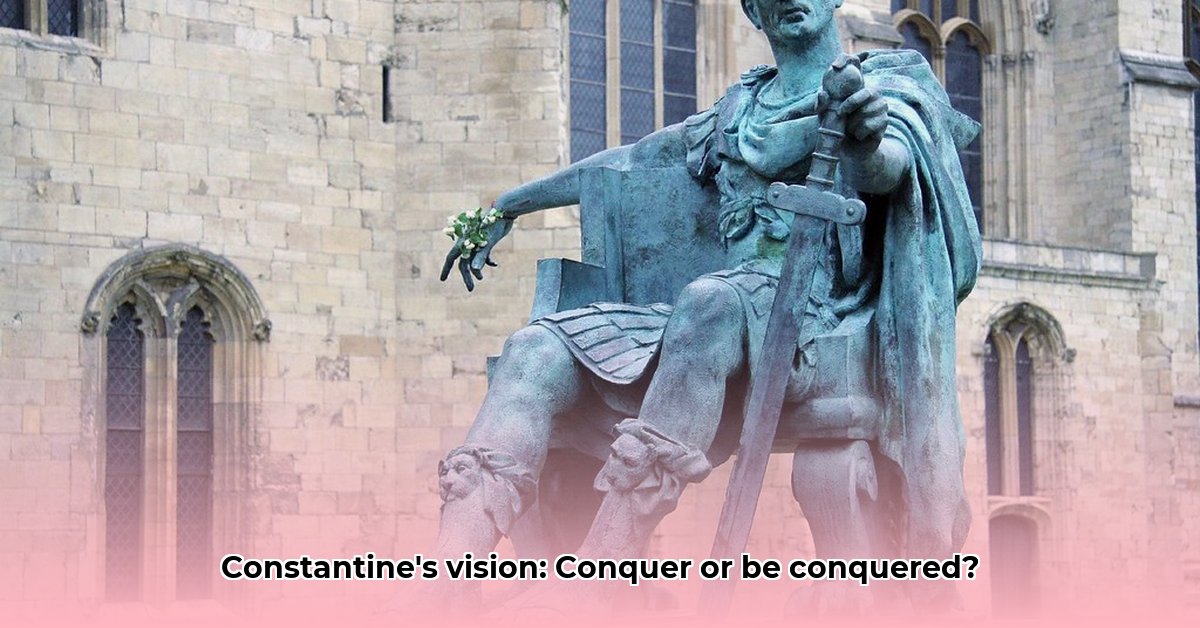Have you ever heard the phrase “In this sign you will conquer”? It sounds like something straight out of a historical epic, doesn’t it? Yet, it’s rooted in historical fact, and deeply intertwined with the story of Roman Emperor Constantine and the rise of Christianity. Was it a genuine divine message that spurred Constantine’s conversion and forever altered the course of an empire? Or was it a calculated political maneuver, masterfully executed? This article delves into the captivating story behind “In Hoc Signo Vinces,” separating historical fact from legend, and exploring its profound impact on history, and its relevance to modern life. We will embark on a journey into the historical details, dissect various interpretations, and uncover the reasons why this ancient phrase continues to resonate centuries later. Prepare for an exploration of history and its unexpected connections to the present day!
Unraveling “In This Sign Conquer”: Constantine’s Vision and Lasting Impact
The phrase “In this sign conquer,” or In Hoc Signo Vinces in Latin, is a compelling piece of history, inextricably linked to the Roman Emperor Constantine the Great. The traditional story recounts that before the pivotal Battle of the Milvian Bridge in 312 AD, Constantine experienced a vision – a radiant cross emblazoned across the sky, accompanied by the Greek words ἐν τούτῳ νίκα (en toutōi nika) which translates to “in this, conquer”. But, did this event actually transpire as described? Herein lies the captivating historical debate. Historians continue to analyze the event’s authenticity, with diverse accounts emerging from various sources. Nevertheless, irrespective of whether it was a literal divine intervention or a strategic fabrication, the profound impact of the story is undeniable.
Consider this: a powerful emperor, on the cusp of a decisive battle, proclaims a divine sign foretelling victory. This powerful image held immense potential for political advantage. Regardless of the vision’s true nature, its subsequent narrative indelibly shaped the destiny of the Roman Empire. Prominent Early Church Fathers like Eusebius of Caesarea and Lucius Caecilius Firmianus Lactantius documented their individual versions of the event, each account differing slightly, thereby contributing to the enduring historical complexity. However, they all agreed on a central point: Constantine’s life, and indeed the empire’s trajectory, underwent a fundamental transformation.
From Divine Revelation to Military Motto: The Evolution of “In This Sign Conquer”
Initially, “In this sign conquer” represented a deeply personal revelation exclusively for Constantine. However, it rapidly transcended its individual significance. In the hands of a shrewd emperor, it evolved into a potent political and military symbol. Suddenly, the Chi-Rho symbol – a monogram created by superimposing the first two Greek letters (Χ and Ρ) of the word “Christ” – was no longer solely a religious emblem; it became a symbol of military prowess. Bearing this symbol, Constantine’s army achieved victory at the Milvian Bridge, forever associating “In this sign conquer” with their triumph.
An intriguing question arises: Was this divine intervention, a savvy piece of propaganda, or an intricate fusion of the two? The answer is likely multifaceted. Yet, irrespective of its genesis, the phrase’s profound resonance and enduring legacy remain undeniable.
Multiple Interpretations of a Powerful Phrase: Unpacking “This Sign”
What precisely is meant by “this sign”? This question has intrigued researchers for centuries, and it continues to be a subject of debate. Did it pertain specifically to the Chi-Rho symbol itself? Or to the cross? Or did it denote something more abstract, such as faith itself? Surprisingly, this ambiguity has only enhanced the phrase’s enduring quality. Its inherent adaptability has enabled it to embody diverse meanings for different individuals throughout various periods. It resembles a chameleon, deftly altering its hues to harmonize with its environment.
Certain scholars propose it was a calculated maneuver by Constantine, aimed at bolstering the morale of his soldiers and consolidating authority within an increasingly Christianized empire. Others assert Constantine’s genuine conviction and his unwavering belief in divine intervention. Irrespective of whether one favors a particular viewpoint or a synthesis of them, the lasting impact is undeniable. The inherent adaptability of its meaning serves as a fundamental element of its longevity.
A Legacy Across Time: “In This Sign Conquer” Through History
Constantine’s triumph at the Milvian Bridge marked only the inception. The phrase “In this sign conquer” expanded across centuries, cultures, and continents. Its influence was not confined to the Roman Empire; its message resonated deeply with diverse leaders and movements, evolving into a symbol of hope, resilience, and the pursuit of victory in both spiritual and earthly contexts.
It appears in military mottos, embellishes religious iconography, and even makes appearances in contemporary films and literary works. Its influence extends beyond its literal Latin origins. The enduring allure of this expression is remarkable. It harmonizes the weight of history, the force of faith, and the universal human aspiration to conquer adversity. It exemplifies the human desire for triumph and the enduring potency of symbols.
The Enduring Power: Why We Still Remember “In This Sign Conquer”
The persistent utilization of “In this sign conquer” surpasses mere historical peculiarity. It reflects something more profound within the human spirit – our unwavering quest for significance and our yearning for fortitude in challenging circumstances. It serves as a powerful reminder that even symbols shrouded in historical ambiguity can transform into potent rallying points, uniting individuals across generations. Whether you perceive Constantine’s vision as entirely mythical, strategically devised, or an authentic divine intervention, the legacy of this phrase continues to resonate powerfully today. In this sense, In Hoc Signo Vinces undeniably continues to conquer.
Delving Deeper: Future Research and Unanswered Questions
Continuing research efforts are continually illuminating the historical veracity of Constantine’s vision and the development of the phrase itself. Experts are constantly scrutinizing primary sources, reevaluating historical narratives, and employing novel methodologies to gain a more comprehensive understanding of the intricate interplay between faith, politics, and military strategy within the Roman Empire. As research advances, our comprehension of “In this sign conquer” may undergo further evolution, uncovering new dimensions of its enduring impact. The narrative is far from concluded. There remains much to uncover regarding the enduring influence of this seemingly simple yet profoundly significant phrase.
Actionable Insights: Exploring the Legacy of “In This Sign Conquer”
| Stakeholder Group | Short-Term Actions (0-1 year) | Long-Term Actions (3-5 years) |
|---|---|---|
| Historians & Scholars | Conduct in-depth analyses of primary sources; comparing and contrasting different historical narratives. | Launch comprehensive studies encompassing religious, political, and social contexts. Foster international collaboration on research efforts. |
| Religious Communities | Integrate the phrase’s story into sermons and discussions on faith and endurance. Facilitate open dialogues exploring varied interpretations. | Develop educational materials examining the phrase’s historical and theological implications. |
| Museums & Cultural Institutions | Create exhibitions showcasing the phrase’s visual and textual representations across history. Curate engaging interactive exhibits. | Develop comprehensive educational programs for public engagement. Establish partnerships with educational institutions. |
| Educators | Incorporate the story of Constantine and “In this sign conquer” into history and religious studies. Focus on critical thinking and historical analysis. | Design educational resources allowing for nuanced discussions on the phrase’s multi-layered meanings. |
How did the interpretation of “In Hoc Signo Vinces” evolve throughout history?
The phrase “In Hoc Signo Vinces”— “In this sign, you will conquer”— holds immense historical significance, profoundly connected to the ascent of Christianity and the Roman Empire. But how did the interpretation of “In Hoc Signo Vinces” evolve throughout history? Its meaning has undergone significant transformations across the centuries.
From Battlefield to Belief: The Early Interpretations
The narrative commences with Emperor Constantine. Historians recount his vision preceding the Battle of the Milvian Bridge in 312 AD. He allegedly beheld a radiant cross in the sky, accompanied by this very phrase. This vision is credited with Constantine’s embrace of Christianity and his subsequent triumph. Consequently, “In Hoc Signo Vinces” became inextricably linked to military success, divinely ordained. The Chi Rho symbol, comprising the initial two Greek letters of Christ, evolved into a potent military insignia. The initial interpretation was relatively simple: Embrace Christianity, and achieve victory. But was the reality truly this straightforward?
Questioning the Narrative: Propaganda or Genuine Faith?
The account of Constantine’s vision, meticulously documented by historians such as Eusebius and Lactantius, presents a compelling, albeit convenient, narrative. Did Constantine genuinely undergo a divine revelation? Or was this a strategically crafted piece of propaganda? Some scholars posit that the emperor shrewdly employed the narrative to legitimize his dominion, consolidating power while concurrently fostering a burgeoning faith. Irrespective of its origins, the vision exerted a monumental influence.
The Symbol’s Transformation: From Military Banner to Religious Icon
Over the course of centuries, “In Hoc Signo Vinces” transcended its initial military connotations. The cross, initially a symbol of execution and disgrace, evolved into an emblem of triumph, its association with Constantine’s victory profoundly influencing its cultural significance. The phrase transitioned from a battle cry to a more expansive articulation of faith and divine favor. Churches and religious orders embraced the motto, reinterpreting it according to their distinct theological tenets. The original military context gradually diminished, superseded by a more spiritual essence. In the fifth century, Christian rulers of the Kingdom of Ak
- Unveiling the Enigma: Mansoureh Khojasteh Bagherzadeh’s Public Appearances & Private Life in Iran - July 18, 2025
- Unveiling the Mystery: Mansoureh Khojasteh Bagherzadeh’s Husband: A Rare Glimpse into a Private Life - July 18, 2025
- Unveiling Masoud Khamenei’s Mother: Power, Influence, and Iran’s Future - July 18, 2025
















